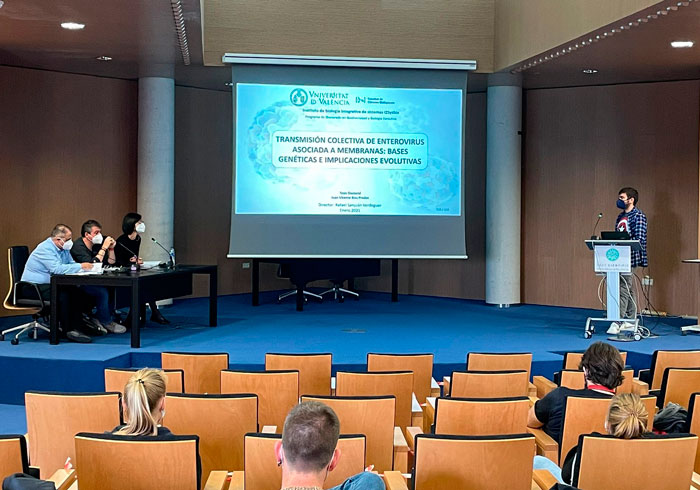
This doctoral thesis, supervised by Rafael Sanjuán, analyses the genetic basis and evolutionary implications related to the collective transmission of membrane-associated viruses using the enterovirus coxsackievirus B3 (CVB3) as an experimental model. The results of the research have been published in the journals Cell Reports and Molecular Biology and Evolution. The thesis was defended on 27 April 2021.
Viruses are responsible for numerous diseases. Thanks to their fabulous adaptive capacity and ease of transmission, they are very proficient at jumping from one species to another, so many viruses that infect animals can cause zoonoses with considerable pandemic potential. Studying and better understanding viruses is essential for health and epidemiology protocols, as well as in the search for new antiviral drugs. In recent years, it has been discovered that viruses can be transmitted in groups from host to host in multiple ways, changing the classical virology paradigm of "one infectious unit = one viral particle". One of the most ubiquitous forms of group infection is membrane-associated transmission. However, both the genetic basis of this process and its evolutionary implications are still an unanswered question. The main objective of this doctoral thesis, entitled "Membrane-associated enterovirus collective transmission: genetic basis and evolutionary implications", is to shed light on these unknowns in an attempt to better understand the evolutionary and genetic basis underlying this mechanism of group transmission, using CVB3 as a study model. Cells infected by this virus release membranous structures containing between 8 and 21 infectious particles on average. To test whether the virus encodes this process in its genome, a directed evolution experiment was performed in which the fraction of viruses that transmit freely or in groups was repeatedly selected. CVB3 responded to this selection regime in a reproducible manner through a series of mutations that altered the ability of the virus to use this form of viral transmission. Moreover, one of the main effects of group transmission is the consequent increase in multiplicity of infection (MOI), which can favour viral cooperation events, but also the emergence of cheater viruses, such as defective interfering particles. To better understand this process, the genetic diversity of membrane-associated CVB3 virion clusters was examined. In most cases, these structures were found not to promote co-transmission of different viral genetic variants from cell to cell, and thus mostly contain viral particles whose genomes are highly related. Finally, increased MOI may also have effects on the efficacy of viral infection that are independent of the associated genetic diversity. When comparing the per capita efficiency of the virus, it was observed that the cost of dispersal is not offset by productivity, but that infection and release of viral progeny in cluster-infected cells appears to be accelerated.
J. V. Bou's thesis was carried out in the Virus Experimental Evolution group at I2SysBio, under the supervision of Rafael Sanjuán (Professor of Genetics at the UV). During the development of the thesis J. V. Bou has enjoyed a contract within a Prometeo project (Generalitat Valenciana). The examining board was formed by Pilar Domingo Calap (I2SysBio, UV-CSIC), Alberto Marina (IBV, CSIC) and Francisco Javier López Labrador (FISABIO), who graded the thesis as outstanding.











